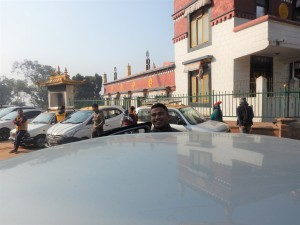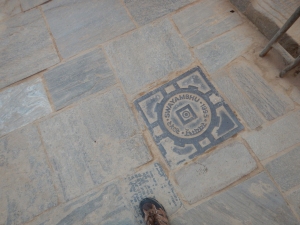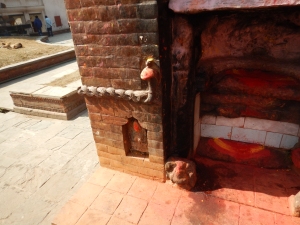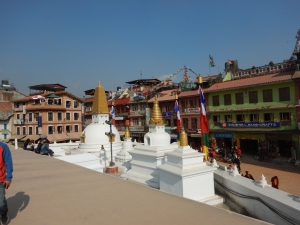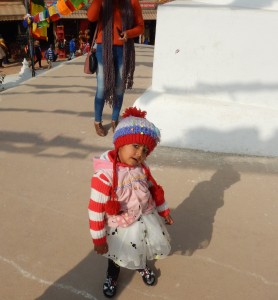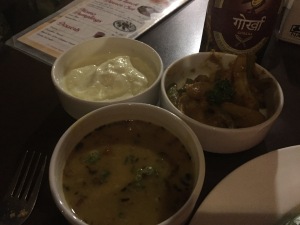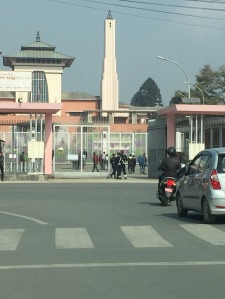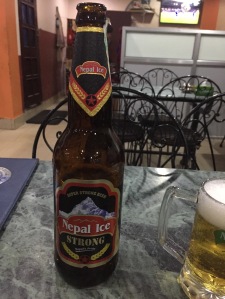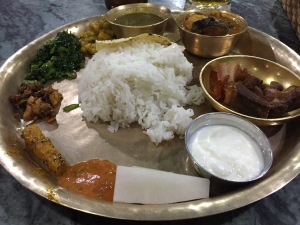There was always something about Nepal that appealed to me, and once this trip started taking shape, I decided that I would not try to go through India, but to start the Asian trip in Nepal after Dubai. It was a colder area than the rest of Asia, and another trip north of the Equator, but besides all of the cultural treasures, Nepal had views of the Himalayas, and Mt. Everest.
Kathmandu is the capital of Nepal, and is located at abut 27 degrees north, and 85 degrees east. One of the strangest things about Nepal is that the time zone is UTC + 5:45, which means that when it is 7am in Texas, it is 8pm in Bangkok (12 hours from Eastern time zone), and 6:45pm in Kathmandu. I am sure there is a reason why it isn’t on an hour (India has a time zone at :30 after the hour), but it is very strange.
Even though Mt. Everest sits at over 29,000 feet high, Kathmandu is only at 1400 meters, so it isn’t at an altitude that bothered me, but I didn’t stay there except for three nights. The air quality is also very bad. There are monkeys in many places in Kathmandu, including outside my hotel. Generally I heard pigeons all around, but this monkey lived very close to my room.
First off, Nepal was difficult to get into for me, and difficult to get out of. We arrived from Dubai only a few minutes late. I was delayed a little bit filling out a form that declared that I had not come from an African (or any) country where I was required to have the Yellow Fever vaccine, since I had come from Africa. By the time I got to Immigration it was around 10pm.
Getting a visa proved a little distressing, since they would not take a credit card, and I couldn’t get an ATM machine to work. The agents really wanted American currency, and I again had to reach into my cash reserve (it was getting close to being depleted, and I knew that I would need some in Cambodia). However, I found some, and got my visa, only to discover that the line to go past Customs was pretty long. I hadn’t travelled enough internationally to realize that every time you entered a new country, you were subject to screening again, and the fact that you hadn’t left the security area did not exempt you from additional screening and Customs for that country.
I also learned that you don’t take pictures of Immigration or Customs officers or security facilities or procedures, or you would lose your camera and possibly be subject to fine and/or arrest. I didn’t try to video them, but I saw enough signs and angry officials to realize that it was not allowed. Therefore there are no pictures of my frustration, which is probably good. I really worked hard to be patient on this trip, but this was not my best hour. I still hadn’t slept since the morning before in Zimbabwe, and now it was over 36 hours ago.
Because I was getting there after dark, I had taken the hotel’s offer of a ride in, and I was worried that the delay would mess that up. However, they were aware of the length of time that it took people to get through the Airport, and had someone waiting to call the driver once I made it through everything.
The good news that night is that one of the screening officers must have been in a hurry, or was frustrated by the delays, because he pointed to me and about five other foreigners, and told us to take our bags and walk through the security device. Because we had not unpacked them, or emptied our pockets, we set off the alarms, but he waved us out of the airport. I didn’t have any checked bags anyway, but it made it easier to finally get out of the airport. Someone met me to tell me that my ride was on the way, and I got whisked to the hotel. The drive at night was a preview of what traffic in Kathmandu was like.
I checked in and made a few calls to home and to the bank about the ATM machines, and my inability to use one in Dubai and Kathmandu. I paid dearly for the calls, because Nepal was not on my phone’s travel plan. The bank officers (it was still during business hours at home) told me that there was no reason why the ATMs should not be working, so I woke up hopeful that a new day would indeed turn things around. This was the most frustrated I would be during the trip, and caused me some doubt that I could do this two month trip.
Prayer flags, above. Kathmandu is an older city, and as I would discovered, had sustained major earthquake damage, the most damaging in 2015.
The hotel had a nice mural, and breakfast was included.
A hotel employee took me to an ATM array, and like slot machines in a casino, some are better to you than others. I had success, and was able to book a tour for the day at the temples I wanted to see. Most of my doubts from the night before vanished. Below, fun fact, the flag of Nepal is one of the few (or maybe the only one) that is not four sided, or rectangular. There are several rivers that flow through Kathmandu, some of them considered holy by the residents, and different religions, predominantly Hindu and Buddhist.
I had a driver come pick me up, and he was going to drive me to several temples on this day. There is no way that I could have driven it myself, for several reasons. One is that there are usually no street names or addresses in Kathmandu, and you find places by reference to some landmark unknown to foreigners. Another is that they will not rent a car to someone without a driver. The third is that I would have been terrified. There are very few lane markers, traffic signs, police officers or rules of the road that I recognized in Kathmandu, the roads are not well maintained, and a driver shares the road with all sizes of vehicles, including thousands of motor scooters or other motobikes. The drivers seem to know every centimeter of their vehicle, and are often within inches of six or seven vehicles, all wanting to go in different directions. As I found out for a lot of my trip, especially in Asia, this was not just traffic in Kathmandu. Apparently only in Japan would we recognize driving like in America, but with a bigger volume and driving on the other side of the road.
My driver did indeed know where he was going, and how to get there. Sometimes there were long delays until the traffic got unsnarled, as there seemed to be no grid system in the city, and you might have intersections with six or eight choices.
The first temple was the one I wanted to see most, or Swayambhu, which I called the monkey temple. First, I was naïve enough to think that I would be able to see the Himalayas from there, since it was set in the mountains, but one of my former co-workers heard me talking about it, and found a website for me to book a mountain flight from the Airport. I already had that scheduled for the next day.
My driver, shown above, would usually find a place to park outside of the temple, and tell me to come back when I was ready to go the next destination. This temple was predominantly Buddhist, and was probably the most popular in Kathmandu.
Above. I quickly learned that what my co-worker had said about Himalaya views from Kathmandu was entirely correct. You couldn’t even see the foothills, because of fog, smog, or some other air quality issue. There were monkeys everywhere, considered sacred by some.
Periodically I would remember my camera phone and take a selfie or some other shot. Another tourist offered to take the picture of my near the monkey. I had not taken rabies shots, so I usually kept my distance from the animals. Note the North Face jacket that I had bought in Indianapolis, one of the first items I bought to prepare for the trip. I drug it all over the world, but it came in handy several times. Below, there were buildings being rebuilt, presumably from earthquake damage, or just general decay due to their age.
Turn these as you pray.
I continued to take in the atmosphere, and noted that there were many vendors at the site, with opportunities to buy souvenirs, food, or other items, including incense or prayer items. They probably paid rent for the space, or a share of their sales, but usually only foreigners would pay a fee to enter the site.
I ran into an English couple, Jack and Layla, and visited with them at the site. I took a picture of Jack with a monkey, and as soon as I put the camera down, the monkey jumped at Jack, taking his spot as Jack scrambled behind me. I also caught a few pictures of the monkeys intimately interacting with each other, usually in return for some food that other tourists gave them. I won’t post those pictures.
After a couple of hours at the temple, we made our way back to our respective cars and drivers, and I headed for Durbar Square, which is known for ancient palaces as well as temples. The driver accompanied me through this area, since he was keeping track of the renovations (it was heavily damaged by the earthquake), and since he said a few prayers at some of the sites. I believe that he was Hindu, or of a certain Hindu sect. Durbar Square is more of a group of palaces, but there are still many altars or places where you can say a prayer or make an offering, both Buddhist and Hindu.
For a lot of these sites, the tourist attractions are buildings or structures within public area of town, and only certain parts of the attraction require a ticket, which may or may not be checked. Usually local residents do not have to have a ticket, and the driver/guides may or may not go with you.
We parked near Durbar Square, and then walked to the area. There were many ceremonial or more traditional clothes on display.
Cows at the site, as well as pigeons. Below, my driver/guide.
Flags for sale. Below, some of the repairs being made to the buildings. Because of the damage, some of the sites were closed or were less accessible, but many of them showed the damage of the earthquake and the work being done to repair the site.
The government of China is working with the government of Nepal to make some of the repairs. They share a common border; in fact, part of Mt. Everest is in China.
Many different forms of transport, including humans.
I had seen this guide and the two girls in Swayambhu, so they were on a similar tour to what I was.
After Durbar Square, he took me Pashupatinath, which is a very holy Hindu temple, on the banks of the Bagmati River, which is considered holy waters. I had heard of it, but had not prepared for it like some of the other temples. It turns out that some of the area is for devout Hindus only, and that they do cremations at the site. Many people were dressed in their finest outfits, and they would pay respect to their ancestors and others that had been sent on their afterlife journey from there. There were many family dinners and ceremonies, and the site is significant for the Hindu community.
As you approached the area, you became aware of many Hindu deities. Below, only Hindus were allowed inside the gates of the main temple. We could only quickly peer inside.
More monkeys, who were considered sacred and protected. There were many private family meals and ceremonies going on, usually in very nice clothes.
Above, below. These were some of the cremations being done on the banks of the Bagmati River. Apparently the bodies would be dipped in the river before being cremated, and then the family leader (usually the patriarch or oldest son) would bathe in the river, and be cleansed, after the cremation.
I saw them earlier, praying, posing, and taking different pictures. I liked the more traditional dress mixed with the more modern. I didn’t ask them to explain the ceremonial aspects, because I didn’t want to pry or be disrespectful. In addition, there was a language issue. If people work in tourism, they usually can speak English, but it isn’t’ fair that we expect people to speak our language in their country.
After the experience at Pashupatinath, I went back and located my driver, and he took me to Boudhanath Stupa, another big Buddhist site, which wasn’t far from Pashupatinath and was really close to the airport. He couldn’t park very close to the Stupa, so he showed me a general area that he would be in, pointed to the roof of the Stupa, and told me to meet him back near where he left me when I was finished. As I mentioned before, the streets are usually very winding, and unnamed, so I made a few wrong turns before I got to the site.
This was a main street that I crossed, and I took a picture of the spot where I needed to go back to the area where he would park. The Western Union sign was also a marker for me, as I wanted to get back to the car.
Once I got through some of the crowded streets, this was the sight that I saw. Note the plane in the sky–we were close to the Airport.
There are many shops and businesses operating in the area, and plenty of things to see inside them. Again, there was a ticket window to buy a general admission ticket, and if I had really wanted to take a more personal tour, and to learn about the site, I could have hired any of the people offering to guide me as I walked around. Again, I didn’t want to be disrespectful, but you can only get so much knowledge of an area in a couple of days. This was primarily a Buddhist holy site.
People walk around these and turn them, as a way of prayer.
I did get permission from her mother, who was standing behind her.
Turning the bell around. The detail was amazing in all of the works.
These guys were Americans, who had been in Asia for a while. They told me that I shouldn’t waste my money on a Himalayan flight, because the weather is always foggy and bad, and that I would never see them. I had already paid for the ticket, and didn’t like what they told me, but thanks for the advice. And as you can see from the next post–I did see the Himalayas!
After leaving that site I followed the signs to get back to where the driver had left me. I begin to fear that he had left me, since this was the last site, but I figured I could take a taxi or bus and get back to the Thamel area, where I was staying. However, I found the car, and then found him a few minutes later, having a snack.
He found his way back, as I was lost most of the way. He dropped me off a couple of blocks away, because it would be too hard for him to navigate his way back, and I managed to find it. Even with narrow winding streets and no street signs, you still had to contend with motorcycles or the occasional car. And remember, they all drove on the other side of the road than I was expecting.
My room. Pretty nice, on the 4th floor, no lift. You can see the bathroom shoes, common in Asia.
I did get up on the roof of my hotel, and take pictures of the area. Again, you could not see the Himalayas from town, so I was glad that I had already booked the flight. I ate at the hotel that night, and had momos and a traditional Nepalese meal, with several courses of meat, vegetables, yogurt, and pickled foods. Oh, and a beer that had to be about 700 milliliters. As Crocodile Dundee used to say–Now, that’s a beer. It was a Gorkha beer, by the way.
When I got back to the hotel, I met another travel guide, who gave me the voucher for my Himalaya flight and told me to expect a driver about 0530. I set my alarms, and had a wakeup call, because I did not want to miss this. I will have those pictures on a separate post.
This is either the seat of the government in Nepal, or maybe the formal palace. Nepal is no longer a monarchy, and the tradition of a king is no longer a part of their existence. They have museums and art galleries all over Kathmandu, but I didn’t have time for them. Maybe next time. I did walk around my hotel a bit (really if you went too far you would get lost), and bought a nice shirt, with an Om symbol, and I ate another traditional Nepalese dish, thakali. Again, the beer was very large, and one would certainly do it.
Above. Franke and Luisa, two German teens travelling in their gap year, after high school (or gymnasium). They had been to India for several months, and then had several months in Nepal. They will probably start university or start jobs in the fall, or maybe not. I met a lot of travelers that really had no concrete plans to go home. Breakfast was always nice, and I usually had a cup of tea with it. Yaks on the back of a 5 rupee note. Nepal used a different currency than India, but they were called rupees as well. There are about 110 rupees in an American dollar.
Below. The red building next to the building being built was my hotel. My room was on that side, and can probably be seen in the photo. Milly and Holly were two English teens, on a shorter holiday than the Germans. They had been to India as well, hence the Henna tattoo.
The plane from Kathmandu to Bangkok took off about three hours late, since it was the return flight of a plane from Bangkok that got there late. I sat at the airport with a French lady for a while, long enough to remember some French, but she didn’t want me to take a picture. Not only did the plane arrive late, but again it was late, long after dark, and it didn’t appear that all of the Immigration agents were there, so the line(s) were slow. There were always questions about who was cutting in which line, and the French lady, who was going to share a taxi with me, had already ditched me, and gone on by the time I got my passport stamped. It turned out to be a lot cheaper to take a taxi (they were metered at the Airport) than I had thought, so I was whisked into the Sukhumvit area of Bangkok, and right to my hotel.
Only three nights in Kathmandu, but again a great introduction to the variety of Asia. I will post the Himalayas flight next. The story deserves its own post.














